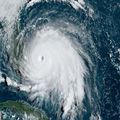TreasureIslandFLGal wrote:Kory wrote:AHS2011 wrote:To add on to my previous question, if Emily stays in the Caribbean long enough, is there a chance that it could miss the trough?
Yes as there is a ridge building in from the NE. She could continue westward slowly and get caught under the ridge dominating the Southeast US and be on her way to Mexico from there.
The posts in this forum are NOT official forecast and should not be used as such. They are just the opinion of the poster and may or may not be backed by sound meteorological data. They are NOT endorsed by any professional institution or storm2k.org. For official information, please refer to the NHC and NWS products.
How would she get "caught under the ridging"? The steering currents around the current ridge she is following would lead her to follow its periphery, which requires her to follow it west and then to the nw and n and finally ne. The 2 ridges don't connect and she wouldn't simply be "passed on" to the other ridge to follow, especially if she is strengthening and drawn naturally more poleward. Its when a storm is drifting around and not already following a ridge that it can get caught by another ridge's steering flow if I understand it correctly. All that said....there is a possibility what you said can happen if Emily gets left behind during her slow movement/stall and the ridge she has been following regresses to the east or northeast quickly, leaving her behind to wander until she can find another steering pattern to be swept into.
Ah yes, but the steering currents are dynamic! The ridge is building back in as the trough moves away (actually its the same ridge thats pushing the trough away along its NW periphery, HP moves LP areas, not the other way, and LP erodes HP areas)
So as the ridge EXPANDS to the west, the storm "could" be caught under the ridge, and a fairly weak bridge could happen with the death ridge in the SE USA.
Here is the GFS at 12 hours.
Note specifically the isobar labeled 1020 and the one just west. That is the western periphery of the HP primarily responsible for current movement. (see the trough east of Massachusetts, labeled 1008? it extends down to roughly the carolinas and georgia).
Here is the GFS at 24 hours.
http://www.nco.ncep.noaa.gov/pmb/nwprod ... p_024s.gifNote the same isobar has moved west? Note the trough has lifted out of the carolinas.
This is a delicate dance, and these are only "predictions" by a model, but if that HP were to move much further west at 24 hours than she would continue to move WNW. Remember, HP moves LP, and LP only erodes HP. A storm cannot move directly into a high pressure area.









